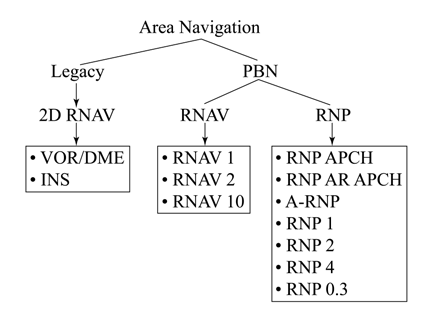Section 2. Performance-Based Navigation (PBN) and
Area Navigation (RNAV)

1-2-1. General FIG 1-2-1
a. Introduction to PBN. As air travel has
evolved, methods of navigation have improved to
give operators more flexibility. Under the umbrella of
area navigation, there are legacy and performance-
based navigation (PBN) methods, see FIG 1-2-1.
The legacy methods include operations incorporating
systems approved under AC 90-45, Approval of Area
Navigation Systems for Use in the U.S. National
Airspace System, which allows two-dimensional area
navigation (2D RNAV) within the U.S. National
Airspace System (NAS). AC 90-45 describes 2D
RNAV in terms of both VOR/DME dependent
systems and self-contained systems such as Inertial
Navigation Systems (INS). Many operators have
upgraded their systems to obtain the benefits of PBN.
Within PBN there are two main categories of
navigation methods: area navigation (RNAV) and
required navigation performance (RNP). For an
aircraft to meet the requirements of RNAV, a
specified RNAV accuracy must be met 95 percent of
the flight time. RNP is an RNAV system that includes
onboard performance monitoring and alerting
capability (for example, Receiver Autonomous
Integrity Monitoring (RAIM)). PBN also introduces
the concept of navigation specifications (Nav Specs)
which are a set of aircraft and aircrew requirements
needed to support a navigation application within a
defined airspace concept. For both RNP and RNAV
designations, the numerical designation refers to the
lateral navigation accuracy in nautical miles which is
expected to be achieved at least 95 percent of the
flight time by the population of aircraft operating
within the airspace, route, or procedure. This
information is introduced in International Civil
Aviation Organization's (ICAO) Doc 9613, Perform-
ance-based Navigation (PBN) Manual (Fourth
Edition, 2013) and the FAA Advisory Circular (AC)
90-105A, Approval Guidance for RNP Operations
and Barometric Vertical Navigation in the U.S.
National Airspace System and in Remote and
Oceanic Airspace (expected publication date in late
2014) further develops this story.
b. Area Navigation (RNAV)
1. General. RNAV is a method of navigation
that permits aircraft operation on any desired flight
path within the coverage of ground- or space-based
navigation aids or within the limits of the capability
of self-contained aids, or a combination of these. In
the future, there will be an increased dependence on
the use of RNAV in lieu of routes defined by
ground-based navigation aids. RNAV routes and
terminal procedures, including departure procedures
(DPs) and standard terminal arrivals (STARs), are
designed with RNAV systems in mind. There are
several potential advantages of RNAV routes and
procedures:
(a) Time and fuel savings;
(b) Reduced dependence on radar vectoring,
altitude, and speed assignments allowing a reduction
in required ATC radio transmissions; and
(c) More efficient use of airspace.
In addition to information found in this manual,
guidance for domestic RNAV DPs, STARs, and
routes may also be found in Advisory Circular
90-100(), U.S. Terminal and En Route Area
Navigation (RNAV) Operations.
2. RNAV Operations. RNAV procedures, such
as DPs and STARs, demand strict pilot awareness and
maintenance of the procedure centerline. Pilots
Performance-Based Navigation (PBN) and Area Navigation (RNAV) 1-2-1